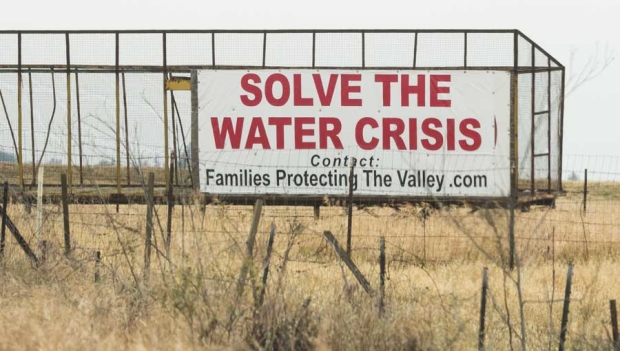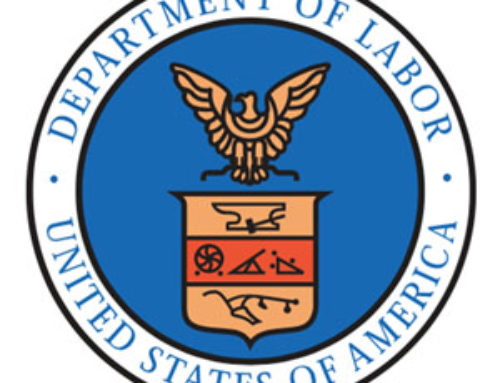
One of several billboards dot California’s Central Valley in April 2015 from agriculture groups trying to increase public awareness of the severe drought hitting the state. (TJ Mullinax/Good Fruit Grower)
With temperatures rising and water restrictions starting in Washington and other western states, several announcements to help growers through the coming season are cropping up. Below are a few notices for water related aid, tips, and workshops that are available to growers.
Save the date: Yakima Basin workshop
Workshop for junior water rights holders in the Yakima Basin who are looking to qualify for emergency groundwater permits are encouraged to attend a May 28 workshop in Yakima, Washington, starting at 3 p.m.
The release states that at the workshop, “farmers can learn whether they qualify for a temporary emergency groundwater permit allowing well water to supplement their irrigation supply under a cost-share drought response program. Most affected junior water users are within the Kittitas Reclamation District, and the Roza and Kennewick irrigation districts.”
The workshop will be held at the Washington Department of Ecology’s Central Regional Office at 15 West Yakima, Ave.
Read the full announcement online at ecy.wa.gov/news/2015/069.html or call 509-575-2597.
$21 million in relief added to Farm Bill for drought areas
Growers in several western states will have aditional relief funding through the Farm Bill to focus on drought mitigation solutions this season.
This aid will be made available to help farmers improve irrigation systems, conservation practices, cover crops, and other water management techniques.
The eight states targeted for this relief include California, Oregon, Idaho, Utah, Nevada, Kansas, Oklahoma, and Texas.
To learn more about the drought investment aid, read 1.usa.gov/1F6Hw2V
Tips for improving orchard water management during a drought
Oregon State University horticulturist Steve Castagnoli wrote up several recommendations for growers with new and existing orchards who are looking for ways to handle this year’s drought.
He also encourages growers to reach out to him if they have further questions about the recommendations at 541-386-3343, ext. 255, or email steve.castagnoli@oregonstate.edu
Read Orchard Irrigation Scheduling — Made Much Easier below.
Irrigation Strategies for Established and New orchards
Established orchards: for pears and apples, avoiding water stress during all stages of fruit growth will help achieve optimal fruit size and yield. Stone fruits (including cherries) have a more complex fruit growth pattern over the course of the season, which sometimes allows imposing deficits without affecting fruit size. Under our conditions, it’s probably not practical to do that, so from bloom to harvest, cherries may be treated similarly to pears and apples.During most seasons, water stored in the soil from winter and spring rain provides adequate water for several weeks after bloom so it isn’t necessary to irrigate during that time. In much of the lower valley, we have recently reached the point where stored soil moisture has been depleted to a point where irrigation is needed. From now until harvest, your challenge is providing trees with adequate water while avoiding excessive irrigation or other inefficient irrigation practices.
One additional note about cherries: after harvest, tree water use is substantially reduced, so irrigation inputs can be reduced also. Todd Einhorn suggests that after harvest irrigating cherries at around 50% of preharvest levels should be adequate for continued normal growth and development.
New plantings: With newly planted orchards, your main focus should be getting trees off to a good start by avoiding any stress due to inadequate irrigation, lack of nutrients, or competition from weeds. Small trees have very limited root systems compared to larger established trees. In newer blocks, you need to start earlier and irrigate more frequently. Because you are managing a shallower root zone, irrigation sets should be shorter. Reducing water in late summer can help acclimate trees for fall and winter cold.
WSU Irrigation Scheduler– irrigation scheduling made much easier
A calendar approach to irrigating rarely matches crop needs for water through the season. Using a systematic, information-based approach to irrigation scheduling will result in big improvements in efficiency and fruit production. Perhaps the simplest of these is a water budget approach where information about your soil, crop, irrigation system, and weather conditions is used to estimate crop water use and provide you with accurate information on irrigation intervals and set times.Information on using the water budget approach is widely available in extension publications and basic irrigation text books. Even though it is fairly simple, using this approach may seem like more trouble than it’s worth because it requires record keeping and periodic calculations.
The good news is that there is free web-based irrigation scheduling tool available through the WSU AgWeatherNet that will do all of the calculations for you. It provides automatically updated estimates of daily water use, available soil moisture, and water deficit values in either inches or hours of set time equal to the amount of water you should apply to bring your soil to field capacity.
The WSU Irrigation Scheduler has many convenient features including the capability to track several orchard blocks independently and access through your mobile device. You do need to set some basic initial parameters, but this requires minimal set up time.
The Irrigation Scheduler uses daily weather data for the calculations. And, although this is a Washington-based system, it provides access to weather data from the US Bureau of Reclamation Agrimet system. We are very fortunate to have four Agrimet stations in the Hood River Valley providing very good coverage for estimating water use under local conditions. In the Irrigation Scheduler these Agrimet weather stations are listed as Dee Flat, Hood River, Parkdale, and Pinegrove (Pine Grove).
Many of you have experience with Watermark sensors. These or other soil moisture monitoring tools are useful for seeing what’s happening in the soil and verifying results of water applied according to the Irrigation Scheduler. For information on using Watermarks, see this publication – https://catalog.extension.oregonstate.edu/em8900.
The Irrigation Scheduler is available free of charge, but first time users do need to register to create an account. To do that, visit the AgWeatherNet homepage – http://weather.wsu.edu/awn.php. There is an Irrigation Scheduler user’s guide with information on getting started and basic information on the water budget approach at: http://weather.wsu.edu/is/ISMManual.pdf.
Current and historical crop water use estimates can also be accessed through the Agrimet system – http://www.usbr.gov/pn/agrimet/or_charts.html.
An important aspect of managing soil moisture is the water holding capacity of your soil, which is dependent on soil texture. The USDA Web Soil Survey is a very useful tool for determining your soil type and water holding characteristics – http://websoilsurvey.sc.egov.usda.gov/App/WebSoilSurvey.aspx.






Leave A Comment